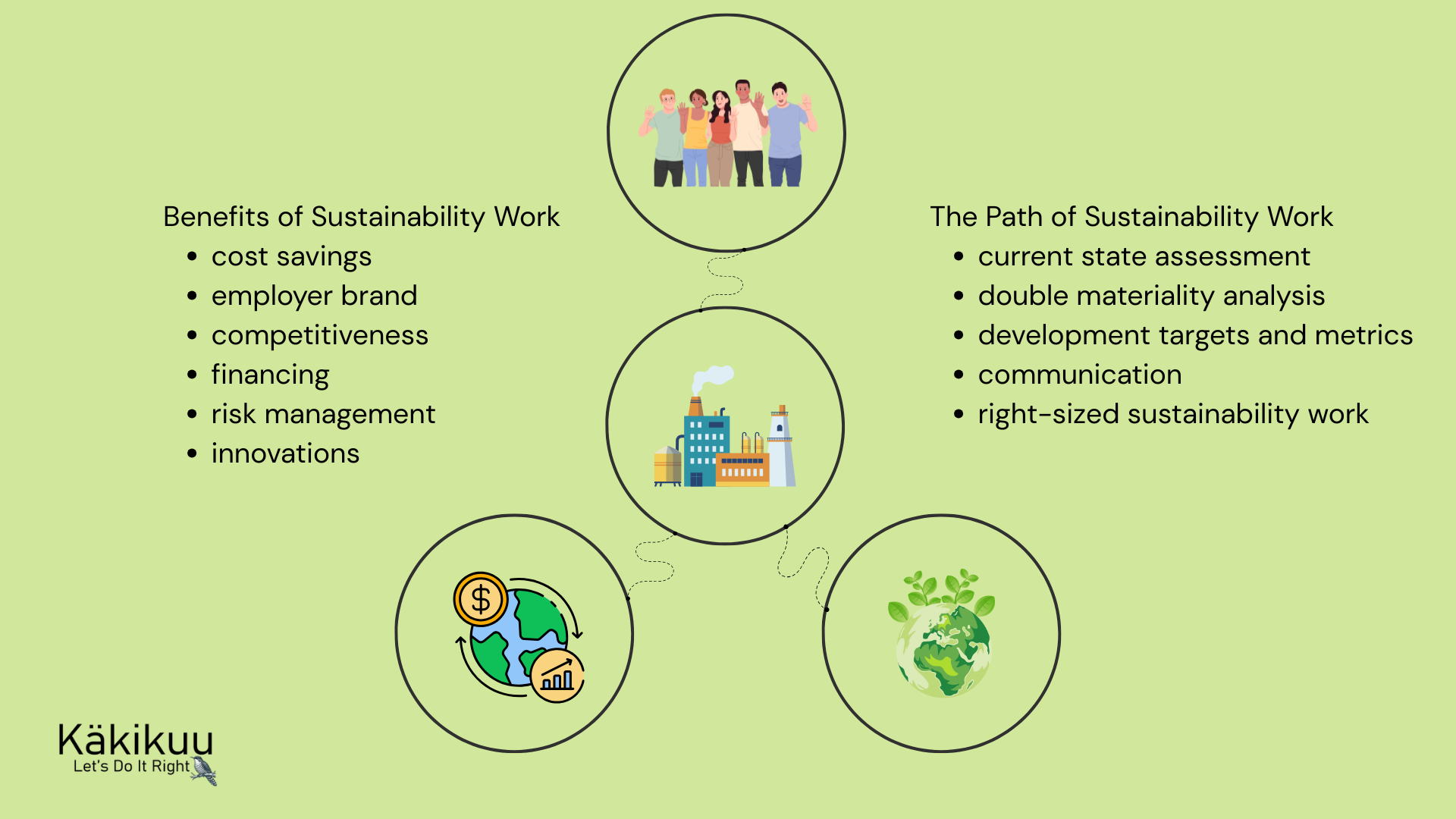Many small business owners still perceive sustainability work as a cost factor or a branding trick, with at best a vague link to the company’s financial success. However, research and real-world experience tell a different story: when implemented strategically — and above all, measured — sustainability is one of the most effective ways to improve profitability, competitiveness, and resilience. Measuring sustainability efforts is the key to identifying their financial impact.
The challenge often lies in the fact that small and medium-sized enterprises (SMEs) already carry out many responsible actions, but they do not recognize them as such, nor do they measure their impact. Why is it beneficial to measure sustainability efforts, and how should an SME measure the financial impacts of its sustainability work and turn it from a cost into a strategic investment?
Why should the financial impacts of sustainability work be measured?
Measuring sustainability work means assigning concrete, numerical values to the benefits that responsible actions generate for the company. It is not complex or expensive — it’s about using existing data and tracking it with clear goals. Measuring is important for several reasons:
- Makes benefits visible: Measuring turns abstract concepts like “reduced environmental impact” into concrete euros. When reduced energy consumption shows up as lower electricity bills, the value of sustainability work becomes easy to understand and justify.
- Justifies investments: If you can demonstrate that previous sustainability actions have generated savings or increased sales, it becomes easier to justify future investments — for example, in more energy-efficient technology.
- Strengthens competitiveness: Measured results are powerful tools for communication and marketing. They build trust among customers, financiers, and other stakeholders — and help your company stand out from the competition.
- Prepares for the future: EU regulations like the Corporate Sustainability Reporting Directive (CSRD) and the sustainability requirements set by large companies for their supply chains are increasing the pressure for sustainability reporting. Companies that already have data and metrics in place will have a competitive advantage.
What can an SME measure? Practical examples
An SME does not need to adopt heavy and complex reporting frameworks, which are often designed for the needs of large corporations. Measurement can start with simple yet impactful actions.
Measurement can start with simple yet impactful actions.
Cost Savings – The Most Direct Path to Profitability
Often, the most significant and easiest-to-verify financial benefits come from direct cost savings.
- Energy consumption: Monitor electricity and heating usage (kWh/m³). Investments in more energy-efficient equipment or the optimization of production processes are quickly reflected in reduced utility bills.
- Waste reduction: Measure the amount of waste generated (kg, tons) and recycling rate (%). Reducing waste lowers disposal fees, and reusing materials reduces raw material costs. For example, a manufacturing company can significantly reduce landfill waste by improving its processes.
- Logistics and fuel: Track kilometers driven and fuel consumption. Route optimization or driver training in eco-driving generates immediate savings.
- Material and resource efficiency: Optimize raw material use and utilize side streams. Applying circular economy principles, such as reusing surplus production materials, lowers procurement costs and strengthens self-sufficiency.
Growth in Sales and Revenue – Responsibility as a Selling Point
Sustainability also opens new opportunities for revenue growth.
- Customer loyalty: Responsibility increases customer trust and commitment. Satisfied and loyal customers are more likely to make repeat purchases and recommend the company to others.
- New customers and markets: A strong sustainability profile can be a decisive factor in competitive bidding and open doors to new customer segments that value sustainable operations.
- Brand and reputation value: A strong and credible sustainability reputation is a valuable asset that improves the company’s negotiating position and attractiveness in the market.
Employee-Related Benefits – A Committed Workforce Is the Backbone of the Company
Sustainability is not only outward-facing — its impact is strongly felt within the organization as well.
- Employee retention: Investing in employee well-being and engagement improves job satisfaction and reduces turnover. Lower turnover means savings in recruitment and training costs.
- Employer image and recruitment: A strong sustainability profile makes the company a more attractive employer and helps attract skilled talent.
- Efficiency and innovation: A committed and motivated team is more productive and innovative. When employees find their work meaningful, they are more willing to contribute to development.
How to Start Measuring?
Start simple: Don’t try to measure everything at once. Choose 2–3 key areas that are most relevant and easiest to measure for your business, such as electricity consumption or the amount of waste generated.
- Use existing data: Look into your accounting records, electricity and water bills, and waste management reports. The information you need often already exists.
- Set clear targets: Define a concrete goal — for example, “We aim to reduce our energy consumption by 10% over the next year.” This makes monitoring and communicating achievements easier.
- Engage your staff: Ask your employees for ideas on savings and efficiency improvements. The best innovations often come from everyday work.
There is no conflict between sustainability work and financial success — quite the opposite. When sustainability efforts are linked to clear, measurable goals, they become a powerful strategic tool that improves profitability, strengthens competitiveness, and builds long-term business resilience.
Every sustainability action, no matter how small, is a step in the right direction. When its impact is measured, it’s also a step toward a more profitable and sustainable business.



